wheel size BMW X3 2012 Owners Manual
[x] Cancel search | Manufacturer: BMW, Model Year: 2012, Model line: X3, Model: BMW X3 2012Pages: 278, PDF Size: 10.15 MB
Page 91 of 278

Message when the system was not
reset
A Check Control message is displayed.
The system detected a wheel change but was
not reset.
Warnings regarding the current tire inflation
pressure are not reliable.
Check the tire inflation pressure and reset the
system.
Malfunction The yellow warning lamp flashes and
then lights up continuously. A Check
Control message is displayed. No flat
tire can be detected.
Display in the following situations:▷A wheel without TPM electronics is fitted:
have the service center check it if necessary.▷Malfunction: have the system checked by
your service center.▷TPM could not be fully reset. Reset the sys‐
tem again.▷Disturbance by systems or devices with the
same radio frequency: after leaving the area
of the disturbance, the system automatically
becomes active again.
Declaration according to NHTSA/
FMVSS 138 Tire Pressure Monitoring
System
Each tire, including the spare (if provided)
should be checked monthly when cold and in‐
flated to the inflation pressure recommended by
the vehicle manufacturer on the vehicle placard
or tire inflation pressure label. (If your vehicle has
tires of a different size than the size indicated on
the vehicle placard or tire inflation pressure la‐
bel, you should determine the proper tire infla‐
tion pressure for those tires.) As an added safety
feature, your vehicle has been equipped with a
tire pressure monitoring system (TPMS) that il‐
luminates a low tire pressure telltale when one
or more of your tires is significantly under-in‐
flated. Accordingly, when the low tire pressure
telltale illuminates, you should stop and check
your tires as soon as possible, and inflate them
to the proper pressure. Driving on a significantly
under-inflated tire causes the tire to overheat
and can lead to tire failure. Under-inflation also
reduces fuel efficiency and tire tread life, and
may affect the vehicle's handling and stopping
ability. Please note that the TPMS is not a sub‐
stitute for proper tire maintenance, and it is the
driver's responsibility to maintain correct tire
pressure, even if under-inflation has not reached
the level to trigger illumination of the TPMS low
tire pressure telltale. Your vehicle has also been
equipped with a TPMS malfunction indicator to
indicate when the system is not operating prop‐
erly. The TPMS malfunction indicator is com‐
bined with the low tire pressure telltale. When
the system detects a malfunction, the telltale will
flash for approximately one minute and then re‐
main continuously illuminated. This sequence
will continue upon subsequent vehicle start-ups
as long as the malfunction exists. When the mal‐
function indicator is illuminated, the system may
not be able to detect or signal low tire pressure
as intended. TPMS malfunctions may occur for
a variety of reasons, including the installation of
replacement or alternate tires or wheels on the
vehicle that prevent the TPMS from functioning
properly. Always check the TPMS malfunction
telltale after replacing one or more tires or
wheels on your vehicle to ensure that the re‐
placement or alternate tires and wheels allow
the TPMS to continue to function properly.
FTM Flat Tire Monitor
The concept
The system does not measure the actual infla‐
tion pressure in the tires.
It detects a pressure loss in a tire by comparing
the rotational speeds of the individual wheels
while moving.Seite 91SafetyControls91
Online Edition for Part no. 01 40 2 608 153 - 09 11 490
Page 221 of 278
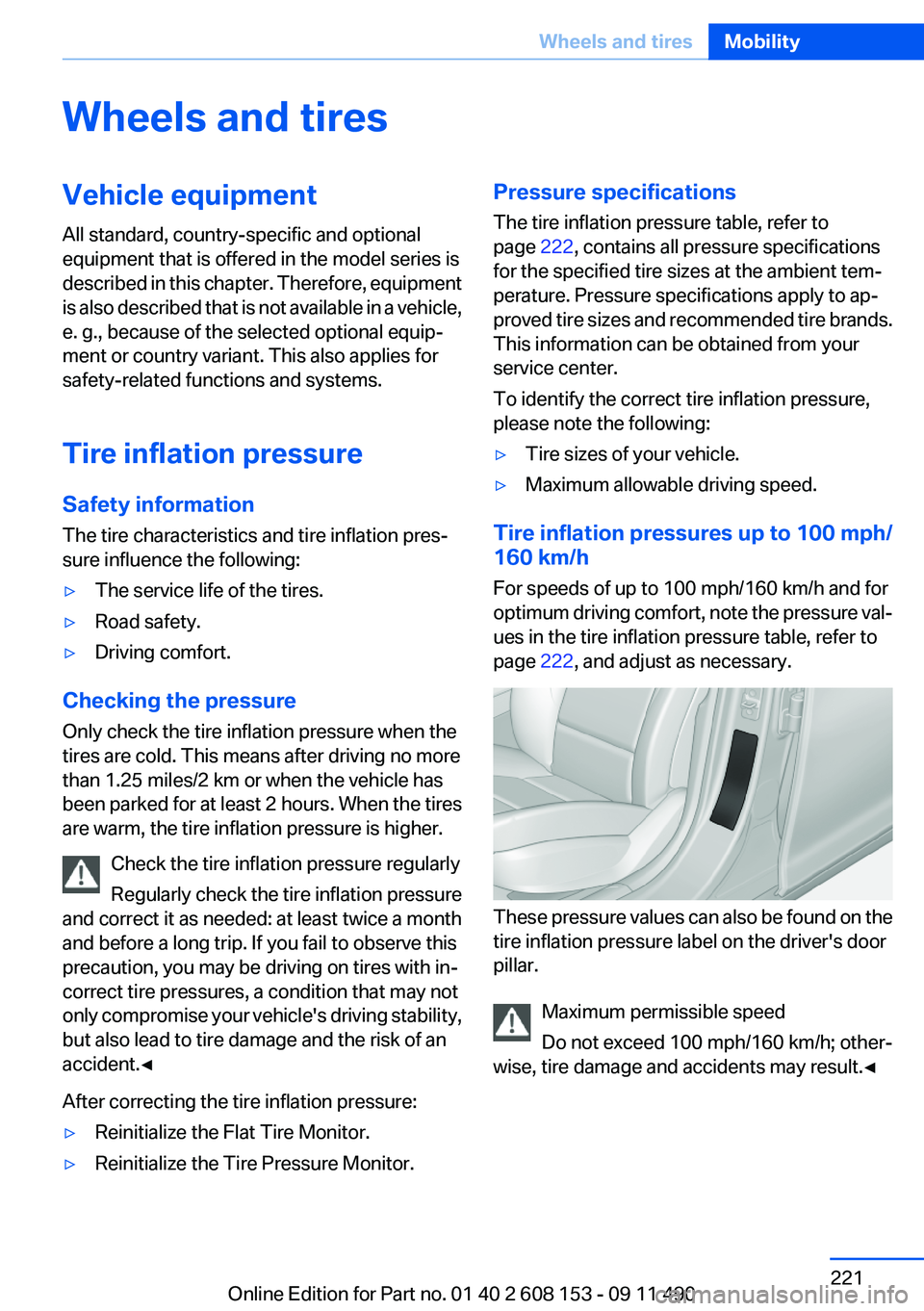
Wheels and tiresVehicle equipment
All standard, country-specific and optional
equipment that is offered in the model series is
described in this chapter. Therefore, equipment
is also described that is not available in a vehicle,
e. g., because of the selected optional equip‐
ment or country variant. This also applies for
safety-related functions and systems.
Tire inflation pressure
Safety information
The tire characteristics and tire inflation pres‐
sure influence the following:▷The service life of the tires.▷Road safety.▷Driving comfort.
Checking the pressure
Only check the tire inflation pressure when the
tires are cold. This means after driving no more
than 1.25 miles/2 km or when the vehicle has
been parked for at least 2 hours. When the tires
are warm, the tire inflation pressure is higher.
Check the tire inflation pressure regularly
Regularly check the tire inflation pressure
and correct it as needed: at least twice a month
and before a long trip. If you fail to observe this
precaution, you may be driving on tires with in‐
correct tire pressures, a condition that may not
only compromise your vehicle's driving stability,
but also lead to tire damage and the risk of an
accident.◀
After correcting the tire inflation pressure:
▷Reinitialize the Flat Tire Monitor.▷Reinitialize the Tire Pressure Monitor.Pressure specifications
The tire inflation pressure table, refer to
page 222, contains all pressure specifications
for the specified tire sizes at the ambient tem‐
perature. Pressure specifications apply to ap‐
proved tire sizes and recommended tire brands.
This information can be obtained from your
service center.
To identify the correct tire inflation pressure,
please note the following:▷Tire sizes of your vehicle.▷Maximum allowable driving speed.
Tire inflation pressures up to 100 mph/
160 km/h
For speeds of up to 100 mph/160 km/h and for
optimum driving comfort, note the pressure val‐
ues in the tire inflation pressure table, refer to
page 222, and adjust as necessary.
These pressure values can also be found on the
tire inflation pressure label on the driver's door
pillar.
Maximum permissible speed
Do not exceed 100 mph/160 km/h; other‐
wise, tire damage and accidents may result.◀
Seite 221Wheels and tiresMobility221
Online Edition for Part no. 01 40 2 608 153 - 09 11 490
Page 222 of 278

Tire inflation pressure values up to
100 mph/160 km/h
X3 28iATire sizePressure specifica‐
tions in bar/PSISpecifications in bar/
PSI with cold tires245/55 R 17 102 H M
+S A/S RSC
245/55 R 17 102 H M
+S RSC2.2 / 322.2 / 32225/60 R 17 99 H M
+S A/S RSC
245/50 R 18 100 V M
+S A/S RSC
225/60 R 17 99 H M
+S RSC
245/50 R 18 100 H M
+S RSC2.2 / 322.4 / 35245/45 R 19 102 V M
+S XL A/S RSC
245/45 R 19 102 V M
+S RSC2.2 / 322.6 / 38V: 245/45 R 19 98 W
RSC
H: 275/40 R 19 101
W RSC2.2 / 32
--
2.2 / 32V: 245/40 R 20 99 Y
XL RSC
H: 275/35 R 20 102 Y
XL RSC2.2 / 32
--
2.4 / 35Compact wheel:
T 135/80 R 18 104 MSpeed up to a max. of
50 mph / 80 km/h
4.2 / 60X3 35iATire sizePressure specifications
in bar/PSISpecifications in
psi/kilopascal with
cold tires245/50 R 18 100 V
M+S A/S RSC
245/50 R 18 100 V
M+S RSC2.2 / 322.4 / 35245/45 R 19 102 V
M+S XL A/S RSC
245/45 R 19 102 V
M+S RSC2.2 / 322.6 / 38V: 245/45 R 19 98 W
RSC
H: 275/40 R 19 101
W RSC2.2 / 32
--
2.2 / 32V: 245/40 R 20 99 Y
XL RSC
H: 275/35 R 20 102
Y XL RSC2.2 / 32
--
2.4 / 35Compact wheel:
T 135/80 R 18 104
MSpeed up to a max. of
50 mph / 80 km/h
4.2 / 60
Tire inflation pressures at max. speeds
above 100 mph/160 km/h
Speeds above 100 mph/160 km/h
In order to drive at maximum speeds in ex‐
cess of 100 mph/160 km/h, please observe, and,
if necessary, adjust tire pressures for speeds
exceeding 100 mph/160 km/h from the relevant
table on the following pages. Otherwise tire
damage and accidents could occur.◀
Seite 222MobilityWheels and tires222
Online Edition for Part no. 01 40 2 608 153 - 09 11 490
Page 223 of 278

Tire inflation pressure values over
100 mph/160 km/h
X3 28iATire sizePressure specifica‐
tions in bar/PSISpecifications in bar/
PSI with cold tires245/55 R 17 102 H M
+S A/S RSC
245/55 R 17 102 H M
+S RSC2.2 / 322.6 / 38225/60 R 17 99 H M
+S A/S RSC
245/50 R 18 100 V M
+S A/S RSC
225/60 R 17 99 H M
+S RSC
245/50 R 18 100 H M
+S RSC2.4 / 352.8 / 41245/45 R 19 102 V M
+S XL A/S RSC
245/45 R 19 102 V M
+S RSC2.6 / 383.0 / 44V: 245/45 R 19 98 W
RSC
H: 275/40 R 19 101
W RSC2.2 / 32
--
2.6 / 38V: 245/40 R 20 99 Y
XL RSC
H: 275/35 R 20 102 Y
XL RSC2.2 / 32
--
2.6 / 38-Compact wheel
T 135/80 R 18 104 MSpeed up to a max. of
50 mph / 80 km/h
4.2 / 60X3 35iATire sizePressure specifications
in bar/PSISpecifications in
bar/PSI with cold
tires245/50 R 18 100 V
M+S A/S RSC
245/50 R 18 100 V
M+S RSC2.6 / 383.0 / 44245/45 R 19 102 V
M+S XL A/S RSC
245/45 R 19 102 V
M+S RSC2.8 / 413.2 / 46V: 245/45 R 19 98 W
RSC
H: 275/40 R 19 101
W RSC2.4 / 35
--
2.8 / 41V: 245/40 R 20 99 Y
XL RSC
H: 275/35 R 20 102
Y XL RSC2.4 / 35
--
2.8 / 41Compact wheel
T 135/80 R 18 104
MSpeed up to a max. of
50 mph / 80 km/h
4.2 / 60
Tire identification marks
Tire size
255/50 R 19 103 Y
255: nominal width in mm
50: aspect ratio in %
R: radial tire code
19: rim diameter in inches
103: load rating, not for ZR tires
Y: speed rating, before the R on ZR tires
Seite 223Wheels and tiresMobility223
Online Edition for Part no. 01 40 2 608 153 - 09 11 490
Page 224 of 278
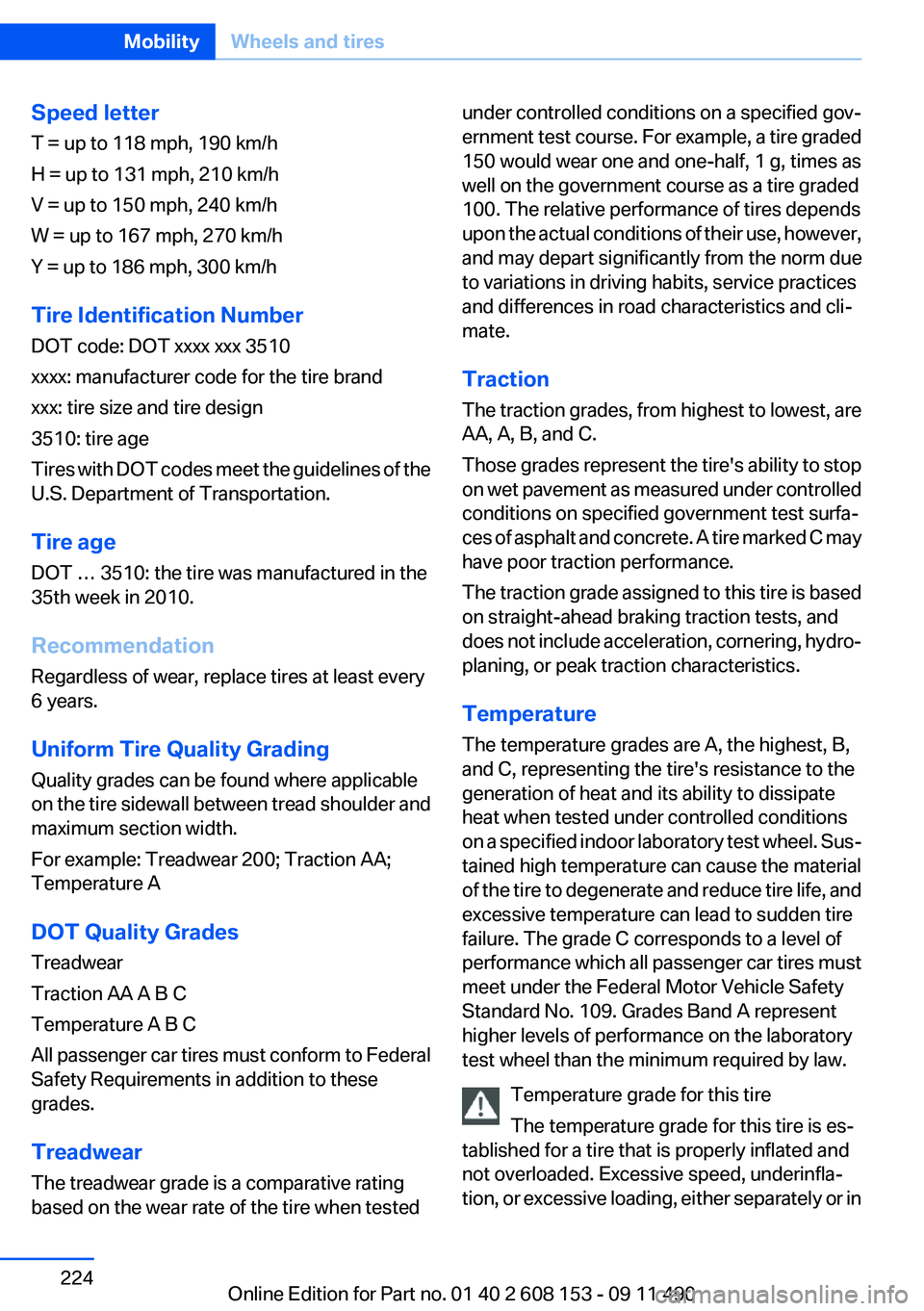
Speed letter
T = up to 118 mph, 190 km/h
H = up to 131 mph, 210 km/h
V = up to 150 mph, 240 km/h
W = up to 167 mph, 270 km/h
Y = up to 186 mph, 300 km/h
Tire Identification Number
DOT code: DOT xxxx xxx 3510
xxxx: manufacturer code for the tire brand
xxx: tire size and tire design
3510: tire age
Tires with DOT codes meet the guidelines of the
U.S. Department of Transportation.
Tire age
DOT … 3510: the tire was manufactured in the
35th week in 2010.
Recommendation
Regardless of wear, replace tires at least every
6 years.
Uniform Tire Quality Grading
Quality grades can be found where applicable
on the tire sidewall between tread shoulder and
maximum section width.
For example: Treadwear 200; Traction AA;
Temperature A
DOT Quality Grades
Treadwear
Traction AA A B C
Temperature A B C
All passenger car tires must conform to Federal
Safety Requirements in addition to these
grades.
Treadwear
The treadwear grade is a comparative rating
based on the wear rate of the tire when testedunder controlled conditions on a specified gov‐
ernment test course. For example, a tire graded
150 would wear one and one-half, 1 g, times as
well on the government course as a tire graded
100. The relative performance of tires depends
upon the actual conditions of their use, however,
and may depart significantly from the norm due
to variations in driving habits, service practices
and differences in road characteristics and cli‐
mate.
Traction
The traction grades, from highest to lowest, are
AA, A, B, and C.
Those grades represent the tire's ability to stop
on wet pavement as measured under controlled
conditions on specified government test surfa‐
ces of asphalt and concrete. A tire marked C may
have poor traction performance.
The traction grade assigned to this tire is based
on straight-ahead braking traction tests, and
does not include acceleration, cornering, hydro‐
planing, or peak traction characteristics.
Temperature
The temperature grades are A, the highest, B,
and C, representing the tire's resistance to the
generation of heat and its ability to dissipate
heat when tested under controlled conditions
on a specified indoor laboratory test wheel. Sus‐
tained high temperature can cause the material
of the tire to degenerate and reduce tire life, and
excessive temperature can lead to sudden tire
failure. The grade C corresponds to a level of
performance which all passenger car tires must
meet under the Federal Motor Vehicle Safety
Standard No. 109. Grades Band A represent
higher levels of performance on the laboratory
test wheel than the minimum required by law.
Temperature grade for this tire
The temperature grade for this tire is es‐
tablished for a tire that is properly inflated and
not overloaded. Excessive speed, underinfla‐
tion, or excessive loading, either separately or inSeite 224MobilityWheels and tires224
Online Edition for Part no. 01 40 2 608 153 - 09 11 490
Page 226 of 278
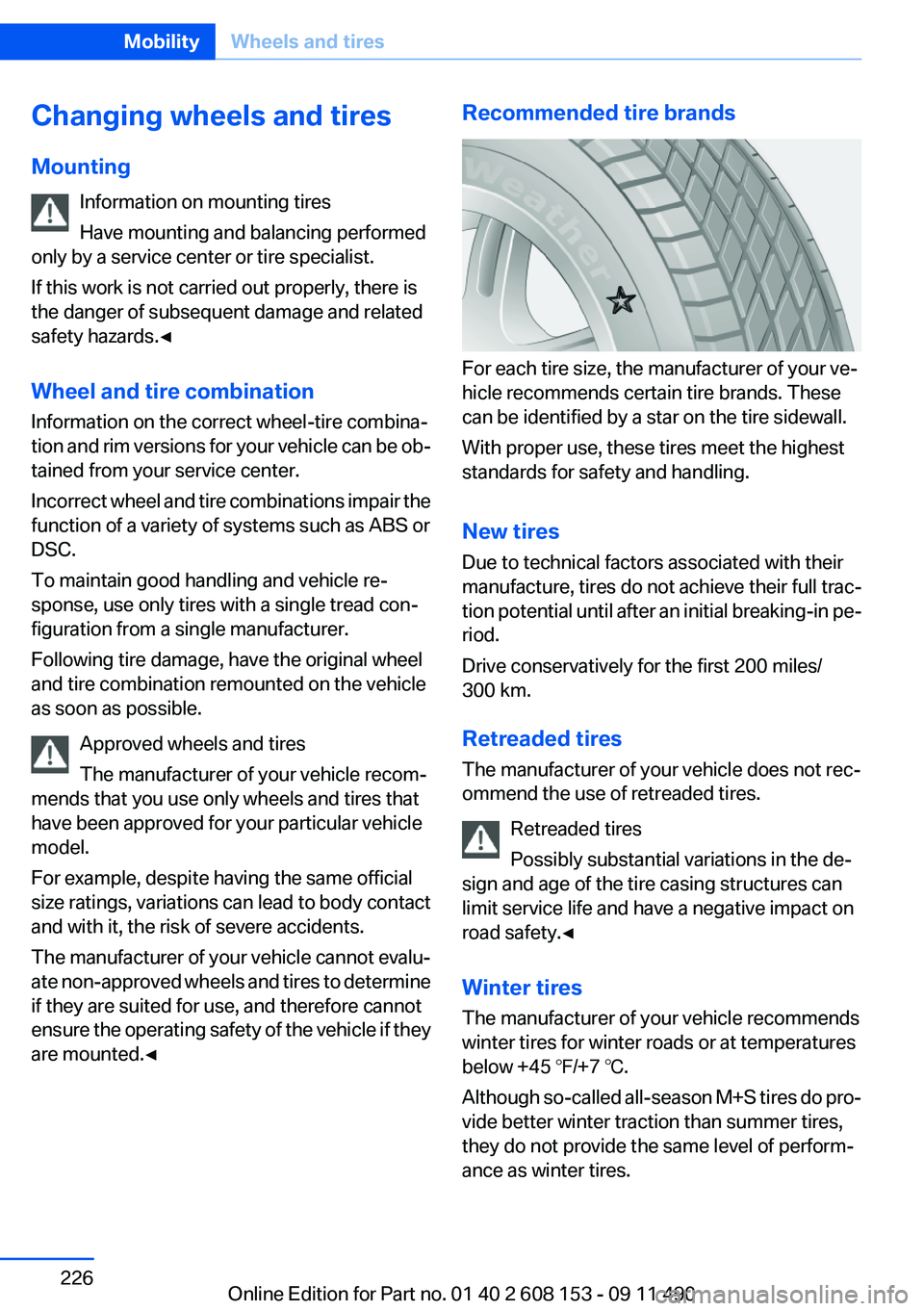
Changing wheels and tires
Mounting Information on mounting tires
Have mounting and balancing performed
only by a service center or tire specialist.
If this work is not carried out properly, there is
the danger of subsequent damage and related
safety hazards.◀
Wheel and tire combination
Information on the correct wheel-tire combina‐
tion and rim versions for your vehicle can be ob‐
tained from your service center.
Incorrect wheel and tire combinations impair the
function of a variety of systems such as ABS or
DSC.
To maintain good handling and vehicle re‐
sponse, use only tires with a single tread con‐
figuration from a single manufacturer.
Following tire damage, have the original wheel
and tire combination remounted on the vehicle
as soon as possible.
Approved wheels and tires
The manufacturer of your vehicle recom‐
mends that you use only wheels and tires that
have been approved for your particular vehicle
model.
For example, despite having the same official
size ratings, variations can lead to body contact
and with it, the risk of severe accidents.
The manufacturer of your vehicle cannot evalu‐
ate non-approved wheels and tires to determine
if they are suited for use, and therefore cannot
ensure the operating safety of the vehicle if they
are mounted.◀Recommended tire brands
For each tire size, the manufacturer of your ve‐
hicle recommends certain tire brands. These
can be identified by a star on the tire sidewall.
With proper use, these tires meet the highest
standards for safety and handling.
New tires
Due to technical factors associated with their
manufacture, tires do not achieve their full trac‐
tion potential until after an initial breaking-in pe‐
riod.
Drive conservatively for the first 200 miles/
300 km.
Retreaded tires
The manufacturer of your vehicle does not rec‐
ommend the use of retreaded tires.
Retreaded tires
Possibly substantial variations in the de‐
sign and age of the tire casing structures can
limit service life and have a negative impact on
road safety.◀
Winter tires
The manufacturer of your vehicle recommends
winter tires for winter roads or at temperatures
below +45 ℉/+7 ℃.
Although so-called all-season M+S tires do pro‐
vide better winter traction than summer tires,
they do not provide the same level of perform‐
ance as winter tires.
Seite 226MobilityWheels and tires226
Online Edition for Part no. 01 40 2 608 153 - 09 11 490
Page 227 of 278

Maximum speed of winter tires
If the maximum speed of the vehicle is higher
than the permissible speed for the winter tires,
then display a corresponding sign in the field of
vision. You can obtain this sign from the tire spe‐
cialist or from your service center.
Maximum speed for winter tires
Do not exceed the maximum speed for the
winter tires; otherwise, tire damage and acci‐
dents can occur.◀
Run-flat tires
For your own safety, only use run-flat tires. No
spare tire is available in the case of a flat tire. Your
service center will be glad to advise you.
Rotating wheels between axles
The manufacturer of your vehicle advises
against swapping wheels between the front and
rear axles.
This can impair the handling characteristics.
Storage
Store wheels and tires in a cool, dry place with
as little exposure to light as possible.
Always protect tires against all contact with oil,
grease and fuels.
Do not exceed the maximum tire inflation pres‐
sure indicated on the side wall of the tire.Run-flat tires
Label
RSC label on the tire sidewall.
The wheels are composed of special rims and
tires that are self-supporting, to a limited de‐
gree.
The support of the sidewall allows the tire to re‐
main drivable to a restricted degree in the event
of a pressure loss.
Continued driving with a damaged tire, refer to
page 93.
Changing run-flat tires
For your own safety, only use run-flat tires. No
spare tire is available in the case of a flat tire. Your
service center will be glad to advise you.
Snow chains
Fine-link snow chains
Only certain types of fine-link snow chains have
been tested by the manufacturer of your vehicle,
classified as road-safe and recommended.
Consult your service center for more informa‐
tion.
Use
Use only in pairs on the rear wheels, equipped
with the tires of the following size:
▷205/65 R 17.▷225/60 R 17.Seite 227Wheels and tiresMobility227
Online Edition for Part no. 01 40 2 608 153 - 09 11 490
Page 228 of 278
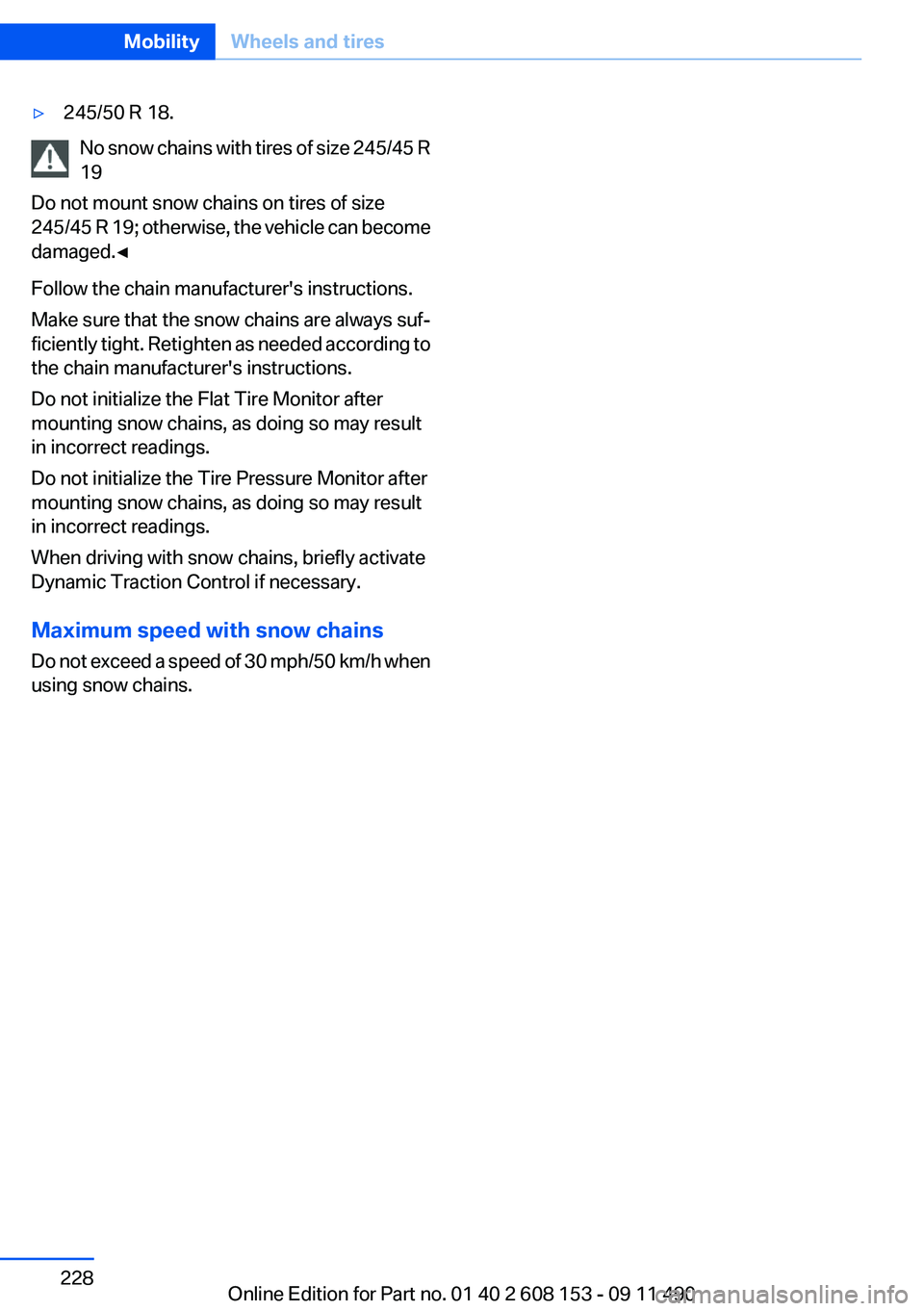
▷245/50 R 18.
No snow chains with tires of size 245/45 R
19
Do not mount snow chains on tires of size
245/45 R 19; otherwise, the vehicle can become
damaged.◀
Follow the chain manufacturer's instructions.
Make sure that the snow chains are always suf‐
ficiently tight. Retighten as needed according to
the chain manufacturer's instructions.
Do not initialize the Flat Tire Monitor after
mounting snow chains, as doing so may result
in incorrect readings.
Do not initialize the Tire Pressure Monitor after
mounting snow chains, as doing so may result
in incorrect readings.
When driving with snow chains, briefly activate
Dynamic Traction Control if necessary.
Maximum speed with snow chains
Do not exceed a speed of 30 mph/50 km/h when
using snow chains.
Seite 228MobilityWheels and tires228
Online Edition for Part no. 01 40 2 608 153 - 09 11 490
Page 274 of 278
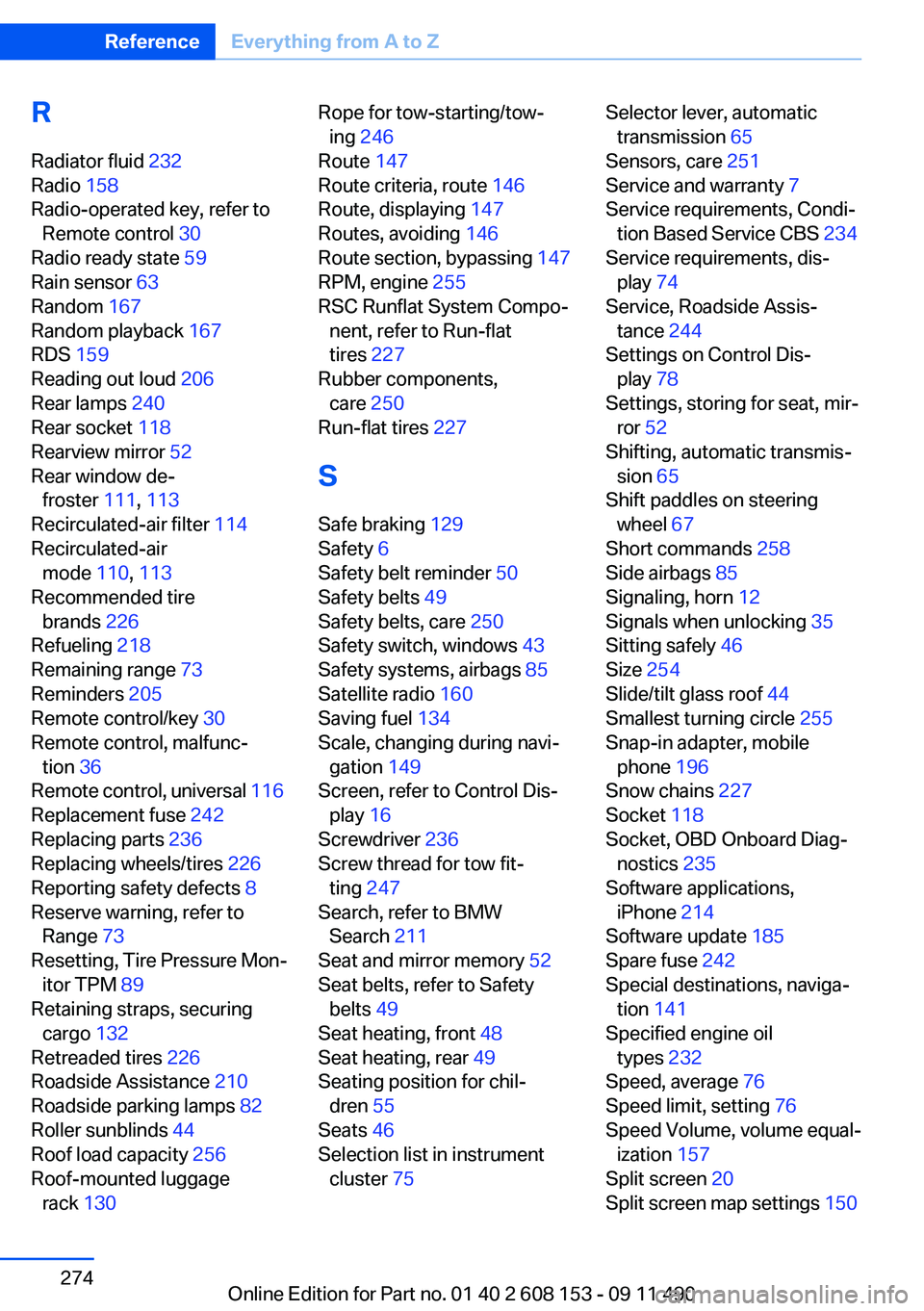
R
Radiator fluid 232
Radio 158
Radio-operated key, refer to Remote control 30
Radio ready state 59
Rain sensor 63
Random 167
Random playback 167
RDS 159
Reading out loud 206
Rear lamps 240
Rear socket 118
Rearview mirror 52
Rear window de‐ froster 111, 113
Recirculated-air filter 114
Recirculated-air mode 110, 113
Recommended tire brands 226
Refueling 218
Remaining range 73
Reminders 205
Remote control/key 30
Remote control, malfunc‐ tion 36
Remote control, universal 116
Replacement fuse 242
Replacing parts 236
Replacing wheels/tires 226
Reporting safety defects 8
Reserve warning, refer to Range 73
Resetting, Tire Pressure Mon‐ itor TPM 89
Retaining straps, securing cargo 132
Retreaded tires 226
Roadside Assistance 210
Roadside parking lamps 82
Roller sunblinds 44
Roof load capacity 256
Roof-mounted luggage rack 130 Rope for tow-starting/tow‐
ing 246
Route 147
Route criteria, route 146
Route, displaying 147
Routes, avoiding 146
Route section, bypassing 147
RPM, engine 255
RSC Runflat System Compo‐ nent, refer to Run-flat
tires 227
Rubber components, care 250
Run-flat tires 227
S
Safe braking 129
Safety 6
Safety belt reminder 50
Safety belts 49
Safety belts, care 250
Safety switch, windows 43
Safety systems, airbags 85
Satellite radio 160
Saving fuel 134
Scale, changing during navi‐ gation 149
Screen, refer to Control Dis‐ play 16
Screwdriver 236
Screw thread for tow fit‐ ting 247
Search, refer to BMW Search 211
Seat and mirror memory 52
Seat belts, refer to Safety belts 49
Seat heating, front 48
Seat heating, rear 49
Seating position for chil‐ dren 55
Seats 46
Selection list in instrument cluster 75 Selector lever, automatic
transmission 65
Sensors, care 251
Service and warranty 7
Service requirements, Condi‐ tion Based Service CBS 234
Service requirements, dis‐ play 74
Service, Roadside Assis‐ tance 244
Settings on Control Dis‐ play 78
Settings, storing for seat, mir‐ ror 52
Shifting, automatic transmis‐ sion 65
Shift paddles on steering wheel 67
Short commands 258
Side airbags 85
Signaling, horn 12
Signals when unlocking 35
Sitting safely 46
Size 254
Slide/tilt glass roof 44
Smallest turning circle 255
Snap-in adapter, mobile phone 196
Snow chains 227
Socket 118
Socket, OBD Onboard Diag‐ nostics 235
Software applications, iPhone 214
Software update 185
Spare fuse 242
Special destinations, naviga‐ tion 141
Specified engine oil types 232
Speed, average 76
Speed limit, setting 76
Speed Volume, volume equal‐ ization 157
Split screen 20
Split screen map settings 150 Seite 274ReferenceEverything from A to Z274
Online Edition for Part no. 01 40 2 608 153 - 09 11 490